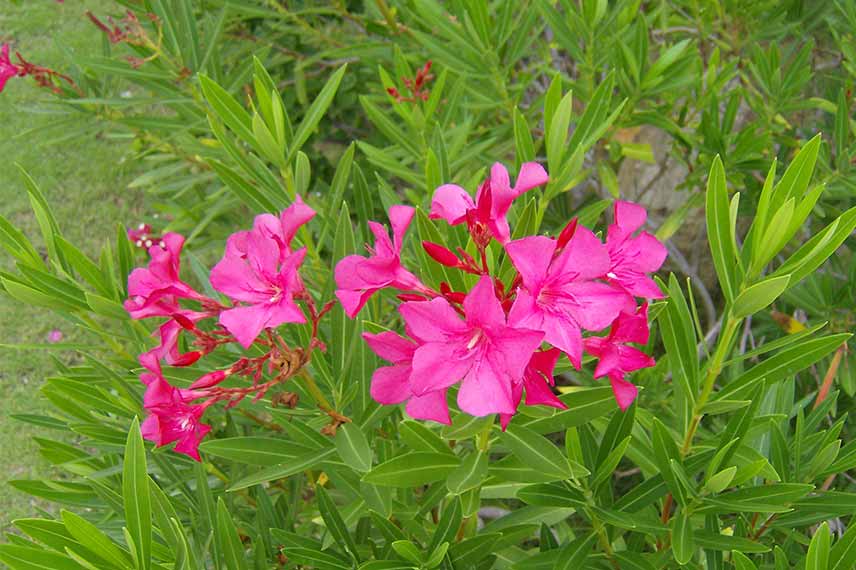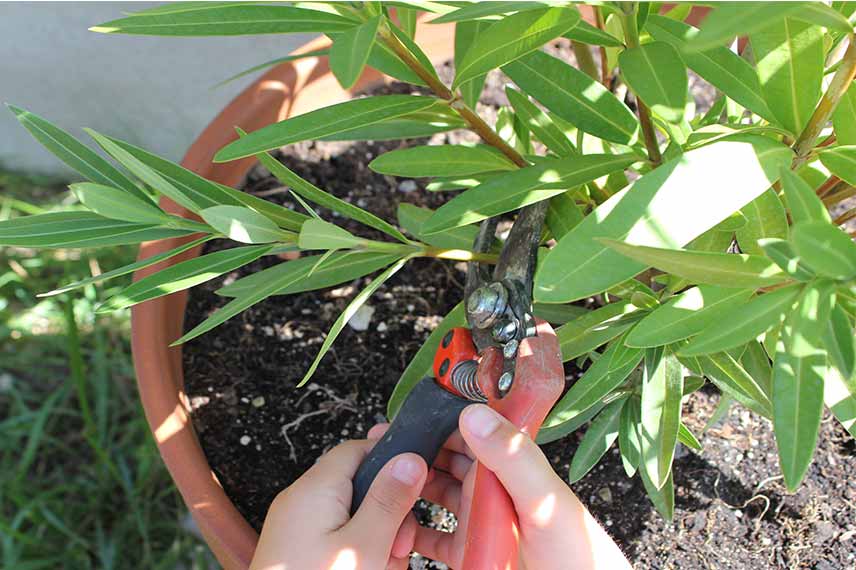Oleander (Nerium oleander) adds a touch of exotica to the garden with clusters of small flowers appearing from June to September and its evergreen foliage of bright green. Whether grown in ground, as a specimen, in a hedge or in a pot on a balcony, pruning remains an important step to enjoy its magnificent summer flowering for many years.
Discover when and how to prune an oleander with our tutorial.

Why prune an oleander?
Pruning an oleander bush helps maintain a compact, harmonious shape. Moreover, this pruning also stimulates flowering by encouraging the plant to produce new shoots. Removing dead or diseased branches also keeps bush healthy. And finally, pruning allows size control, especially if it becomes a little too invasive!
When to prune an oleander?
Nerium flowers on current year’s wood with blooms at branch tips, so pruning should be carried out every 4 to 5 years for those in ground, every 2 years for those in tubs or pots and in a moderate way.
When to prune an oleander in ground: pruning period is early spring, in April. However, prune just after flowering if bush is in a pot or if you live in a mild climate. In mild climates, you can prune oleander until the end of September.
Never prune your oleander in autumn, as this would compromise its spring flowering and make it vulnerable to cold.
Important: bear in mind bush should be at least 5 years old before being pruned.
In August and September, use pruned material to make cuttings. To succeed with propagation by cuttings, see our advice sheet: Propagate oleander: when and how, our advice.
How to prune an oleander?
Equipment needed
To prune oleander, equip yourself with the following:
- pair of gloves, as whole plant is toxic
- clean, sharp pruning shear for small branches
- loppers for older branches
- bag or bin for green waste
- soft tie
Pruning oleander step by step
Here are key steps to successfully prune oleanders and maintain an impeccable silhouette:
- Start by removing dead, diseased wood and old branches;
- Also cut off spent flowers;
- Pinch young shoots at tips;
- Cut branches that cross inside bush to improve air circulation and avoid disease or pests;
- Generally, cut branches by one third of their length, as branches need some length to bear flower buds;
- Dispose of cut branches to avoid contact with children or pets;
Be gentle, because overly severe pruning may compromise flowering.

Performing a simple prune keeps oleanders looking their best and well flowered. © S.Chaillot
Specific pruning for oleander
How to train an oleander as a standard?
A standard oleander looks great on a balcony or terrace. Starting from a young bush, train it from the first years and prune annually. Here are main steps to prune an oleander in a pot and on a stem:
- Place a stake in oleander pot;
- Cut lower branches back by one third of height of oleander;
- Tie trunk to stake;
- Keep upper branches to form an irregular silhouette or a round head;
As it develops, remove suckers appearing at surface or on trunk and cut new branches appearing along trunk height. Gradually, you will form a standard bush while keeping desired silhouette.
How to prune an oleander that has been frost-damaged?
Despite precautions, your oleander may have suffered periods of frost. You may notice some branches have blackened and some leaves are scorched. Don’t panic! From spring, around March or April, cut away blackened parts using a clean pruning shear and preserve parts that are still green. You can cut up to 10 cm from the base or right down to the base if frost has severely damaged stems. Remove damaged leaves. Branches and leaves will regrow and silhouette will thicken over a few years. Your oleander will get a second chance and you will be able to enjoy its magnificent summer flowering.
How to prune an oleander that is bare at the base?
Whether grown in ground or in a pot, oleander can become bare at the base. To restore an attractive silhouette and encourage regrowth, carry out a spring pruning once frosts of the Ice Saints have passed (11, 12 and 13 May). Using a pruning shear or loppers depending on stem diameter, cut back all branches by one third, also removing dead or damaged stems. Then allow time for oleander to grow and fill out. It may not flower in year of pruning, but will provide a profusion of flowers in following summers.
To learn more:
- Discover our advice sheet Oleander: planting, pruning and maintaining and range of colours offered for oleanders.
- To choose right plants, we recommend using our Plantfit web application!
































Comments